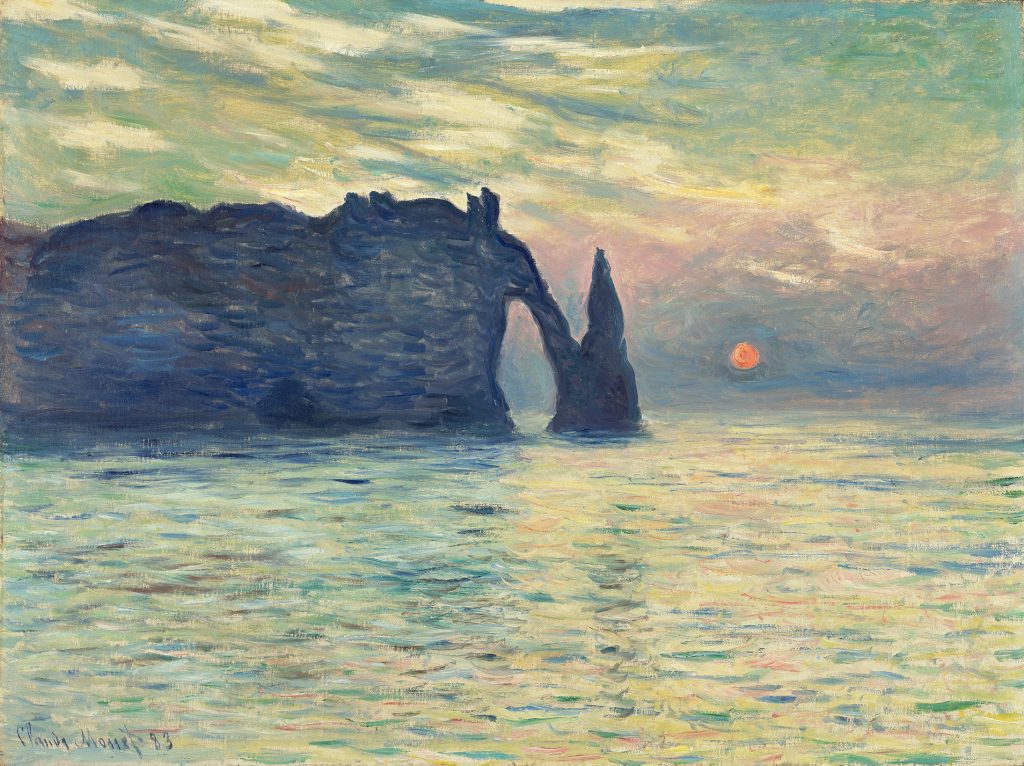Pierre Peyron (artist)
Ambitious young artists in eighteenth-century France aspired to the prestigious Grand Prix award, which...
view artistStudents will understand how the discovery of new elements (such as cobalt, cadmium, and chromium) in the 1700s and early 1800s led to the creation of new artistic materials, which led to the innovations in artistic style made by impressionist painters in the late 1800s.

The Cliff, Étretat, Sunset, by Claude Monet
1. Show students Peyron’s The Death of Alcestis. Ask students to list the colors the artist used in the painting and describe the selection with a few adjectives. Are they bold, bright, drab, pure, transparent, etc.? Have students compare past and present artists’ materials, sources for materials, and working methods. Ask students to define the term pigment and consider the binders that might be mixed with pigments to make paint. (Linseed oil is a common oil binder; egg yolks are mixed with pigment to make tempera paint.)
2. Show students the traditional artist’s palette (bottom palette in image) and explain that Peyron would have used a similar combination of colors when painting The Death of Alcestis. Ask: Do you notice any missing colors? (There is no true green.) How might the artist have created green? (mixing) Explain to the students that prior to the 1700s, only about 30 pigments were available for the oil painter to use. Of these 30 pigments, only approximately 15 were widely used. The remaining pigments were too expensive, toxic, or difficult to work with, or they faded easily in bright light. The pigments on the traditional palette had been available to the artist for hundreds of years. For example, ochre (a yellow to reddish brown) and black can be found in cave paintings from prehistoric times. Ask: Based on the visible properties of the pigments, what types of materials do you think were used to make these two pigments? (earth; charred wood or coal) What pigments might you be able to make from North Carolina’s natural resources? (Red might be created from North Carolina red clay. Black could be made from charred wood or coal.)
3. Have students compare the colors they see in Claude Monet’s The Cliff, Étretat, Sunset with those of The Death of Alcestis. Ask them to describe Monet’s palette with a few adjectives. Ask the students to compare the impressionist palette to the traditional palette. Share with the students that in the year 1700 about 15 chemical elements were known. By 1850 about 40 additional elements had been discovered. Some of these new elements, such as chromium, cadmium, and cobalt, were particularly useful in creating pigments. The development of these inexpensive pigments was fueled by the need to mass produce colored materials such as clothing, curtains, and wallpaper in the wake of the Industrial Revolution. The dissemination of these pigments in the art market was only a byproduct of this development.
Homework: Have each student complete The Hunt for New Elements activity.
4. Assign or have students choose one of the following pigments to research further (providing each student with a Palette Card to assist them with their research):
Tell students they are the manufacturers of their assigned pigment and must create an advertisement that they will present to the class. The ad should include:
a. Image of pigment
b. Pigment name
c. Chemical compound from which pigment is made
d. Date of discovery of the pigment
e. Reasons the pigment is better than others of the same color
f. Process for manufacturing the pigment
g. Health hazards associated with the pigment and the elements or compound from which it is made. (To find health hazards, do a Web search for MSDS (Material Safety Data Sheets) followed by the compound name. For example, “MSDS cobalt chloride.”)h. Drawbacks of the pigment (for example, fading, dries slowly)
i. Persuasive language that demonstrates understanding of target audience
Students may refer to Pigments through the Ages and Revolution in Paint for more information.
Written by Deborah Boxall, Chemistry Teacher
• Participation in group discussion will demonstrate students’ understanding of the interrelationship between advances in technology and the discovery of new artistic materials.
• Completion of The Hunt for New Elements activity will demonstrate students’ understanding of the relationship between the location of an element on the periodic table and its physical and chemical properties.
• Participation in group discussion will demonstrate students’ understanding of the factors that contributed to the evolution of artist palettes and style.
• Completion of the pigment advertisement will demonstrate students’ ability to research a topic, complete a cost/benefit analysis of the pigment, and prepare a persuasive argument in support of the pigment.
Vocabulary
pigment
binder
tempera
palette
Industrial Revolution
element
symbol
periodic table
compound
Materials
Palette Cards (see downloads below)
Links
Ambitious young artists in eighteenth-century France aspired to the prestigious Grand Prix award, which...
view artistBorn in Paris in 1840, Monet, at the age of five, moved with his parents to the Norman port of Le Havre....
view artist